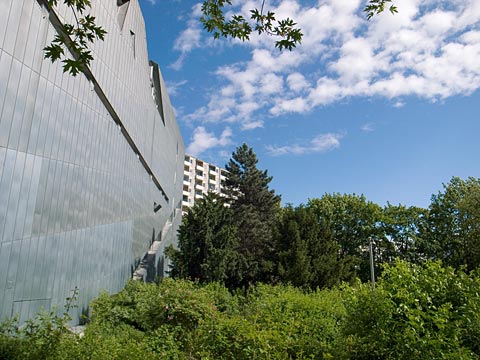Day Four
My last day shooting in Berlin, the weather was tumultuous with dark clouds sweeping across the sky, sudden showers and gusts of wind. It ‘s the kind of day that can drive you crazy trying to manage the view camera and keep your wits about you. But it can also lead to moments of visual drama. Fortunately, Anamarie, my friend from New York–living in Berlin for many years–came along for moral support and help with my equipment.
We began, not by shooting, but by visiting several galleries on the Zimmerstrasse near Checkpoint Charlie, where the Wall used to run down the middle of the street. The building we went into was in East Berlin in those days. We stopped in Galerie Nordenhake and saw photographs by Esko Mannikko from Finland, someone I’d never heard of. The images were close-ups of horses and farm animals lit sharply with flash and printed in fairly contrasty saturated color. A number of the images focused on eyes, sometimes closed, sometimes open. At first glance I thought the images relied too much on the gimmick of tight cropping, but as I rounded the gallery I began to warm to them, and concluded that there was something deeply felt about the images. At the gallery desk I leafed through selections of the photographer’s other work, and found them equally compelling. Will watch for his work in the future.
On the outside of the gallery building, words were printed on a blank wall, one of many such surfaces exposed by the bombing of World War II. The words, in German, were quotes from a homeless man talking about his life situation. The show continued inside where there were videos of various homeless men accompanied by similarly printed quotes. The work was well-done, but I’ve always been wary of this kind of aestheticizing by artists, however admirable the intention.

Milovan Markovic – Homeless Berlin 2006, Zimmerstrasse
near Checkpoint Charlie
Most of the afternoon was spent photographing the Jewish Museum, the famous Daniel Libeskind building on Lindenstrasse. Up to this point I had never attempted to photograph the museum largely because it was not directly along the path of the Wall. But having finished the Lost Border book, I no longer felt constrained by previous limitations. The museum, of course, has been photographed by any number of serious architectural photographers and photo-journalists, so it was not my intention to add to that body of work.
When I first visited the museum the present exhibition had not yet been installed. The empty interior spaces, employing allegory and geometric abstraction, presented Jewish history as a harrowing experience . As pure structure, the museum functioned to a great degree as a Holocaust memorial. The exhibition, however, is a historical overview of Jewish life in Germany and attempts to show the richness of Jewish culture, not just its tragic aspects. Unfortunately, for me, the exhibition is at odds with the architecture of the building, and neither comes off very well. Libeskind’s echoing emptiness is stuffed with bric-a-brac. And the exhibit itself would have been better off displayed in conventional rectangular rooms.
But outside, the museum’s zig-zagging electricity remains as strong as ever, though its severity is somewhat softened by the lushness of the garden surrounding it, especially in late May. Most pictures of the museum don’t show the fact that it is located in a largely low income neighborhood of Kreuzberg. High rise towers with balconies festooned with satellite dishes indicate the presence of immigrants. The great irony of the Jewish Museum’s location is that it sits in the midst of a largely Muslim neighborhood.

Jewish Museum, Berlin with nearby low income apartment tower
In the landscape surrounding the museum, the cuttout lines and slashes of the facade are delineated on the ground as well. Steel rails vector away from the building. Except for a fenced section in the rear that presumably needed to be protected, the landscape appears borderless, filtering out into the neighboring parkland. I did several photographs that attempt to show this integration of landscaping, though I doubt that any will be wholly successful. Other pictures I made illustrate the closeness of the adjacent housing projects. Go here for Google satellite view of the Jewish Museum.
From there I headed back toward Checkpoint Charlie, taking pictures of interesting urban layering along the way. I did two pictures that include one of my favorite modern buildings in Berlin. The GSW building by Sauerbruch Hutton. At Checkpoint Charlie I had hoped to get a photograph of the crazy kitsch that now serves as historical monument to one of the most important and sensitive spots of the Cold War. The early ’60s checkpoint shed has been recreated complete with protective sandbags, and actors in American and Russian uniforms stamp tourists’ passports with phony East German day visas. But the street was in shadow, so I used my last sheet of film elsewhere. Go here for real checkpoint shed in 1987.